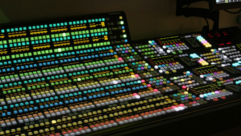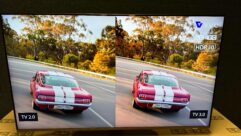
Technology Showcase: Fiber Routers and Matrix Switchers
Mar 1, 2008 12:00 PM,
Bennett Liles
Fiber takes signal switching further.

Extron Electronics Fiber Matrix 6400
During the past few decades, as audio and video signals have been routed and switched in crossbar frames and matrix units, the capabilities of these components have grown and evolved, along with the connected equipment and the signals passing through. When desktop computers entered broadcast and other video facilities, switching capabilities expanded to include keyboard and mouse control. The evolution continued with the advent of AES, DVI, HDMI, USB 2.0, FireWire, and other new digital video formats, but along with the latest signals came some new limitations on the distance they could travel on copper lines.
The first hardware iterations used with fiber-optic transmission took the form of existing switching units employing external electro-optical conversion between the switching matrix and the fiber lines, but of course, the natural progression was toward direct fiber connection. With fiber adoption rapidly gaining ground, many current matrix switching products are either built exclusively for fiber signal switching or exist as rack units that can be equipped with fiber-connection modules just like their pre-existing copper-interface cards. Now, most of the fiber- matrix switchers available are fully scalable. They can be customized with any combination of interface modules, and they offer optical multicasting and automated script, RS-232, or web-based control and configuration.
AC power backup, security features, and configuration storage and recall are primary factors to consider in these hardware products because they are high-uptime, mission-critical items charged with plant-wide interconnection of audio, video, KVM, and control signals. Load-sharing, redundant, hot-swappable power supplies are common, and automated email notice of power supply failover has become standard, as well. Security features normally include proprietary switching protocols, user-group access rights, and exclusive administrator access to diagnostics and layered control functions. Login requiring user ID and password is a common feature that sets user access levels automatically. Source and destination grouping is easily accomplished, and the information can be stored through a web-based browser interface, a serial connection, or a manufacturer-supplied, configuration-software application with graphical display features and drag-and-drop functionality. With the plethora of video formats and the various limitations these may have in terms of transmission distance and equipment compatibility, the evolution of AV routers and matrix switchers has continued with automatic internal format conversion. This internal conversion, coupled with the physical-interface customization afforded through the use of slide-in transmitter/receiver modules, provides the ultimate in mission-specific configurability.
Available products now range from single rack units suited to relatively light-duty local routing to expandable multirack models handling signals from worldwide operations and incorporating the sophisticated self-test, diagnostic, and total failover features required of high-uptime, heavy-load routing systems. The lines sometimes blur in terminology and market-targeting strategies, but the products listed here have the capability to connect directly through fiber and other types of physical interfaces and switch AV — and, in most cases, other types of signals — through fiber lines in a number of current formats.
Technology Showcase: Fiber Routers and Matrix Switchers
Mar 1, 2008 12:00 PM,
Bennett Liles
Fiber takes signal switching further.

AMX EpicaDG
THE FIELD
The EpicaDG’s (Digital Generation) from AMX
two primary roles are signal conversion and fiber transmission. By
converting the incoming signals into a unified digital platform, the
system converts analog and digital video in RGBHV, DVI, HD-SDI, and
SD-SDI formats for anything-in, anything-out operation. Typically, such
equipment can be found in an environment in which both local and
long-distance signals need to be intermixed with complete versatility.
The EpicaDG accomplishes this by providing configurability including
DVI and other native-local-format connections with ports for 12-fiber,
multimode MTP cable in 50um/125um or 62.5um/125um sizes. These provide
fiber line lengths up to 3000ft. for input and output signals
supporting LCD display resolutions up to 1920×1200 and CRT resolutions
up to 1600×1200. The rack chassis is also equipped with
cable-management bars for secure tie-down. The fiber ports may be
custom-configured along with DVI-D modules for local sources with bit
rates up to 2.65Gbps and cable equalization up to 50ft. Each of the DVI
boards allows up to 16 signal interfaces, and the fiber boards each
contain a local-signal DVI connector. The EpicaDG also offers RS-232
control, standard redundant hot-swappable power supplies, advanced
system diagnostics, programmable macro functions, TCP/IP control, and
free APControl software.
Evertz offers the X-3232-EO
electro-optical router in a 2RU frame for switching digital signals up
to 3Gbps on 16 electrical and 16 optical inputs and outputs. The
optical wavelengths of 1310nm or CWDM are available on the outputs
while the inputs will accept any wavelength from 1270nm to 1610nm. The
fiber signals attach on SC/PC, ST/PC, and FC/PC connectors. The
electrical connections use BNC connectors carrying video, audio,
datacom, or telecom signals. In broadcast mode, the unit can send any
input to any number of outputs with internal optical-to-electrical and
electrical-to-optical conversion. The X-3232-EO is compatible with
single-mode and multimode fiber-optic cable, and SNMP remote router
control and monitoring is available with the Evertz X-NCP2 control
panel or via the Evertz VistaLink software application. VistaLink
offers remote terminal-equipment configuration, fiber-module health
status and link monitoring, discrete signal monitoring,
multiwall-display monitoring, hardware-fault alarms, and configuration
change notices. The application also features fault-alarm logging,
visual status, and audible alarms to complement email and pager
notification, contact closures, and secure access control. The
Alarm-event Notification Client allows users to define alarms and set
various severities and conditional filters for critical alarms.
The Extron Electronics Fiber Matrix
6400, introduced at InfoComm 07, has brought a new level of versatility
to the switching-system market for complete end-to-end digital
AV-signal transmission and routing over fiber-optic cable. Expandable
from 8×8 up to 64×64, the system is compatible with the Extron Fox
500-series and HD-SDI fiber-optic transmitters and receivers. The Fiber
Matrix 6400 supports data rates up to 4.25Gbps for computer-video
resolutions up to 1600×1200, DVI-D, and multirate SDI. System
monitoring, hot-swappable I/O boards, and redundant hot-swappable power
supplies are among the primary features the switchers offer. Built on a
rack frame that provides eight card slots, the unit interfaces using
LC-style connectors on each eight-port card. The cards come in two
versions: The Fiber Matrix I/O Board-MM supports 850nm multimode
connections, and the Fiber Matrix I/O Board-SM takes single-mode or
multimode fiber at 1310nm. The boards may be used in any combination.
Each board’s fiber ports exist as a separate input and output, but they
can be configured as a linked input/output supporting bidirectional
capabilities for a Fox 500-series product. The monitoring system
provides self-diagnostics for the I/O boards, fiber links, power
supplies, internal fans, and general functions of the switcher.
Front-panel LED indicators provide quick verification of signal
presence and status.
Technology Showcase: Fiber Routers and Matrix Switchers
Mar 1, 2008 12:00 PM,
Bennett Liles
Fiber takes signal switching further.

Harris Platinum Opto+
The new Grass Valley Optical Switch
Router (OSR) is the newest member of the Acappella family of small
routers. The OSR can be configured either symmetrically or
asymmetrically, with port counts in multiples of four from 8×8 to
32×32. Physically, the OSR is packaged in a 19in. frame — either 1RU
(up to 16×16) or 3RU (port counts greater than 16×16) — and 14.7in.
deep. Two connector types can be provisioned, either LC or FC/APC with
redundant AC powering. The OSR’s photonic switch core is both
format/protocol- and data-rate-independent. Any signal that can be
transmitted over a fiber can be switched — RF, SD/HD, Ethernet, serial
in either single-mode or multimode (including CWDM), and bidirectional
traffic. Performance is enhanced because there is no signal conversion
from electrical to optical. The OSR can be operated as a standalone or
a network element within the Encore platform via Ethernet or serial
communication. The OSR’s impressive specs include less than 1dB of
optical attenuation, greater than -70dB crosstalk, and a 10-millisecond
switching time.
For direct fiber I/O connectivity, Harris
offers the Platinum Opto+ modules, the PT-OXS-IB+ and the PT-OXS-OB+,
for its large and medium-sized Platinum routers. This teams the
processing power of the Platinum line with the capability to handle
longer HD-SDI signal transmission with a 3Gbps (1080p) infrastructure.
The Platinum Opto+ modules use standard small-form-factor (SFP)
connectors, and they support FP or DFB lasers in the transmitters
(PT-XOS-OB+) and PIN or APD receivers (PT-OXB-IB+) for pricing to suit
the transmission distances required. The Opto-equipped Harris Platinum
routers may use either single- or multimode fiber. The Platinum MX can
scale up to a 128×128 switching matrix in a 9RU frame for HD-SDI, SDI,
ASI, and analog video with AES and analog audio. The modules are
front-loading and hot-swappable, scalable in groups of eight inputs or
eight outputs with redundant controllers and cross-points, along with
load-sharing power supplies. In a 5RU frame, the unit can scale up to
72×64 and up to 144×128 discrete audio channels. Automatic format
conversion allows a complete variety of any input signal type to any
output format. Hardware and software provide a number of control
solutions.
In sizes from 1RU to 9RU, the MultiDyne
EOS-4000 fiber-optic switcher is scalable in matrix sizes from 32×32 up
to 288×288 for video signals up to 4.25Gbps. With SFP transceivers on
all ports, the unit has hot-swappable port cards, power supplies, and
fans. Accepting up to three modular port cards, each with up to 48 SFP
transceiver modules, the EOS-4000 groups the physical ports on each
card as input/output pairs for 850nm, 1300nm, and 1550nm optical media.
Also swappable is the CompactFlash card that acts as the CPU hard drive
for storing the controlling software and non-volatile configuration
data. Configuration commands are received on a 10/100 Ethernet
connection, and they enable the unit to emulate optical power break
with and without path failures; make topology changes; and reroute
point-to-point, loop, or multicast connections. Also available is
dynamic device testing to simulate faults and identify improperly
operating devices. The EOSXplorer software interface provides graphical
displays with the EOS physical view, logical view, chassis health
monitor, and port card health monitor. The user can simply click on any
port and drag it to any other available port — or, in logical view, the
user can employ a drag-and-drop technique in a Windows Explorer-style
display. The health-monitoring displays use gauges and graphs.

Opticomm OptiLinx OLX-3000
The OptiLinx OLX-3000 from Opticomm can
switch digital video up to 4.25Gbps on any of its 144 ports (4RU model)
or 288 ports (8RU model). Available link rates include 1.0625Gbps,
1.25Gbps, 2.125Gbps, 2.5Gbps, and 4.25Gbps. Full-duplex switching
capacity extends up to 612Gbps. The chassis accepts a variety of
modular port cards with SFP transceiver modules for specific network
configurations. These can include point-to-point, multiple loops, and
multicast topologies simultaneously. Each of the transceivers presents
a physical connection for an optical input-and-output pair. The port
cards are hot-swappable, as are the fans and power supplies. Any
wavelength — standard 850nm, 1310nm, 1550nm, multimode or single mode,
or CWDM and DWDM — is supported with complete optical transparency in
links up to half a mile. Remote monitoring and control is facilitated
with a drag-and-drop graphical interface using Opticomm LinxView
software. Configuration and out-of-band control options include the
ability to quickly isolate interconnect problems, evaluate the
reliability of network data transfer, test hardware configurations, and
simulate faults. All of these operations are done through 10/100
Ethernet and RS-232 ports using simple, intuitive command sets to
establish links, change topologies, and emulate optical power breaks
with and without path failures.
Technology Showcase: Fiber Routers and Matrix Switchers
Mar 1, 2008 12:00 PM,
Bennett Liles
Fiber takes signal switching further.

QuStream Cheetah 512XR
For handling relatively heavy fiber routing loads, QuStream
offers the Cheetah line of high-definition routers and conversion
products including the Cheetah XR multirate routing switcher series in
two frame selections. The 512XR can be configured as a 512×512 or
1012×128 or 512×256 in a 27RU frame. Also available is the 1024×512
1024XR in a 41RU frame or as a 1024×1024 in two rack frames. There is
internal conversion for HD to SDI, digital to analog, and fiber I/O —
all on interchangeable rack cards for custom configuration. Control,
configuration, and diagnostics are facilitated with 3500PRO,
3500PRO-LE, PERC2000, and Viewport diagnostic software through
redundant matrix-frame controller cards. All frames have single-point
lockdown for quick, hot-pluggable removal and insertion of input and
output cards, and redundant AC power. There is a 9-pin
serial-communications port for RS-232/RS-422 and a looping connector
for the Pesa Routing Control (PRC) connection. There are frame and
system-control alarm connections, NTSC/PAL and SMPTE reference
connections, and an RJ-45 connector for a matrix-frame controller using
a 100Base-T Ethernet network. The removable door provides easy access
to all internal components, including the high-density, hot-pluggable,
front-loading matrix cards.
For long-distance routing of high-resolution video, USB 2.0, keyboard, mouse, and serial and audio signals, Thinklogical
offers the DCS digital cross-point matrix switch in three sizes,
providing matrix configurations from 32×32 to 144×144 ports. The DCS
has a modular design consisting of separate chassis for video and the
other signals. The two are connected on a dedicated network and
function as one. Both provide hot-swappable, redundant power supplies
and fans, along with fiber ports in groups of eight or 16. Video and
audio sources may be multicast to multiple ports or broadcast to all
output ports. The Linux CPU runs a graphical user interface that allows
alphanumerically identified sources to be arranged in physical and
logical groups, with configuration changes made on the fly. The
Thinklogical line of fiber-optic KVM extenders complements the DCS
matrix switch.
The Utah-400 series of digital routing switchers from Utah Scientific
covers a wide range of applications including standard- and
high-definition video and AES/EBU digital audio switchers in various
matrix sizes. The fiber-optic input/output option allows fiber lines to
connect to the Utah-400 routing switcher frame with I/O boards, each of
which handles eight signals. Internal converter boards hold
electrical/optical and optical/electrical converter blocks, which can
be removed from the rear of the frame for servicing and field
installation. Rear-panel assemblies facilitate access to the converter
blocks for fiber-optic cables with either single or dual-LC connectors.
Each block carries two signals, and four blocks fully equip each
8-channel board. The eight inputs and outputs per board allow a signal
range of 6 miles for HD video and 10 miles for SD. Coax and fiber
connections may be mixed in the frame in any combination. The Utah-400
series features a cross-point-redundancy option in all matrix sizes,
redundant power supplies and controller cards, signal presence
detectors on all inputs and outputs, an internal monitor matrix, and
low power consumption. A single 4RU frame unit can house a 64×64
matrix. This can be expanded all the way up to a 160RU, 20-frame unit
carrying an 1152×1152 switching matrix.
For More Information
AMX
www.amx.com
Evertz
www.evertz.com
Extron Electronics
www.extron.com
Grass Valley
www.thomsongrassvalley.com
Harris
www.harris.com
MultiDyne
www.multidyne.com
Opticomm
www.opticomm.com
QuStream
qustream.com
Thinklogical
www.thinklogical.com
Utah Scientific
www.utahscientific.com










